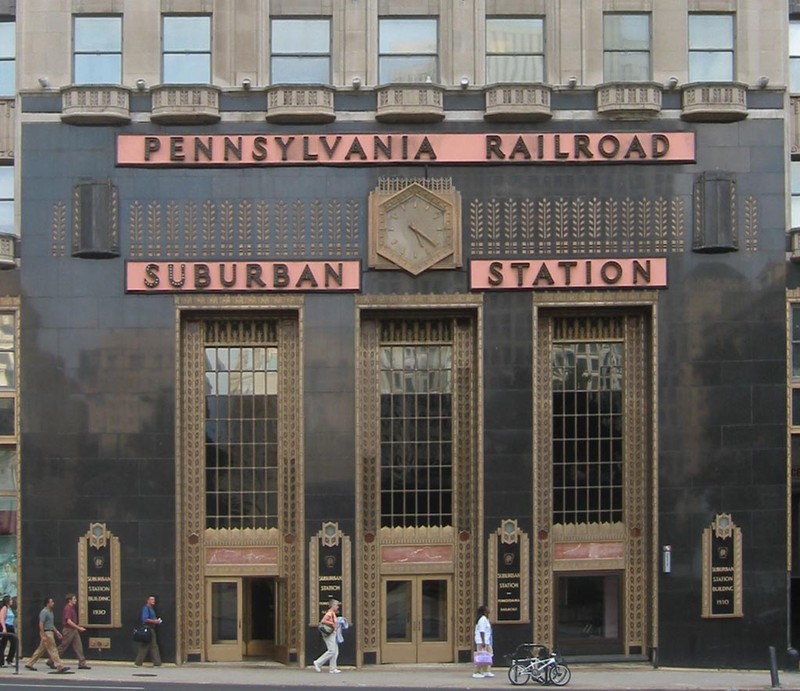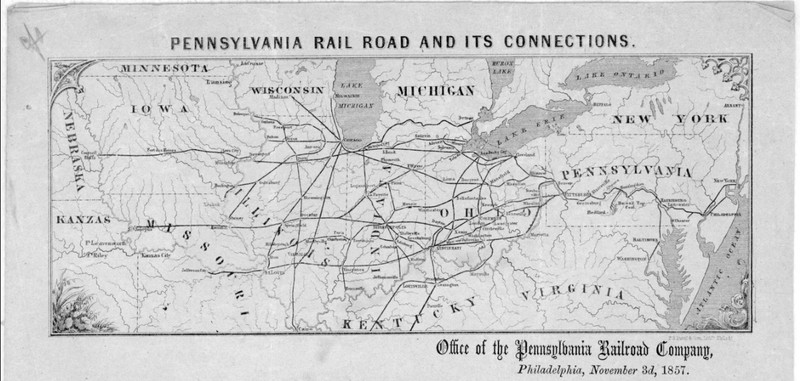Pennsylvania Railroad Suburban Station
Introduction
Text-to-speech Audio
Originally known as the Broad Street Suburban Station Building, this historic structure officially opened on September 28, 1930. The twenty-one-story Suburban Station Building was constructed as an office building while the station below served passengers traveling on the lines operated by the Pennsylvania Railroad Company. The building is one of the city's premier examples of the Art Deco style and is a free-standing, twenty-one-story office tower sitting over a portion of the massive below-grade Penn Center Station that continues to serve passengers.
Images
Pennsylvania Railroad Suburban Station

Pennsylvania Railroad Trunk Lines

Pennsylvania Railroad Trunk Lines

Backstory and Context
Text-to-speech Audio
The Pennsylvania Railroad Company grew from a regional steam-powered line in the early nineteenth century to one of the largest trunk-line railroads connecting the East Coast to the nation's interior. The company's origins date back to the early 1820s when, in an effort to recover trade lost to the opening of the Erie Canal, the company built a rail line between Philadelphia and Columbia, Pennsylvania. The company's growth occurred during the 1840s when it laid rail lines that extended into other states in association with receiving its charter from the Pennsylvania legislature in 1846. The company's rail lines reached Chicago in 1856 after purchasing the Pittsburgh, Fort Wayne & Chicago Railway.
The Pennsylvania Railroad Company initially concentrated on carrying freight, with more than 1,000 freight cars serving warehouses, coal yards, and depots along the waterfront and up and down Broad Street. However, by the 1860s, the railroad's focus turned increasingly towards the expansion of passenger traffic, and the company soon captured a significant share of travel within the city. After the Civil War, the Pennsylvania Railroad Company expanded its reach to such cities as St. Louis, Cincinnati, New York City, and Washington, D.C., ultimately operating a 10,000-mile railway system. Its growth during the nineteenth and early twentieth century coincided with (and played a big part in) the nation's broader railroad and transportation network expansion, as well as the nation's robust industrial and commercial growth. Indeed, the Pennsylvania Railroad Company supported one of the nation's largest systems of rail arteries and subsidiary trunk lines by the early twentieth century.
In addition to its regional presence, the Pennsylvania Railroad Company proved integral in Philadelphia's transportation network, running tracks along its busiest streets. The 1880s represented a crucial period of local growth for the company as the construction of a passenger bridge across the Schuylkill River linked its West Philadelphia lines with Center City, resulting in a marked increase in passenger traffic and the creation of its Main Line commuter railway. The company ultimately developed one of the country's most extensive suburban commuter systems.
The 1920s were the peak of Pennsylvania Railroad Company's period freight and passenger traffic, and in 1923, the Railroad Company's Board began plans to develop a central passenger station on the west side of the Schuylkill River along with a new underground station in the heart of the city. The Railroad sought to build a large office tower housing the company's executive offices and commercial office spaces, headquartered above the new downtown commuter station. Thus, a commuter could ride the train from his or her suburban home directly to the office above the station.
Originally known as the Broad Street Suburban Station Building, the structure officially opened on September 28, 1930, roughly one year into the Great Depression. The company hired the esteemed Chicago architectural firm of Anderson, Probst & White, the successor firm to the venerable D.H. Burnham & Company and Graham & Burnham & Company. The firm gained fame for its public buildings and large commercial commissions, including several imposing buildings for the Pennsylvania Railroad Company. Anderson, Probst & White employed the Art Deco style in the Suburban Station Building. Its size spans a city block and, when it opened, stood alone. Its size and ornamentation, and purpose, made it a landmark. Today, modern high-rise towers surround Suburban Station Building and this historic railway station survives as a reminder of the nature of Philadelphia's downtown business district of the early twentieth century.
Cite This Entry
Powers, Mathew and Clio Admin. "Pennsylvania Railroad Suburban Station." Clio: Your Guide to History. December 23, 2022. Accessed April 22, 2025. https://theclio.com/entry/161436
Sources
"1846: The Pennsylvania Railroad is Established." Transportation History. April 13, 2020. https://transportationhistory.org/2020/04/13/1846-the-pennsylvania-railroad-is-established/.
Mintz, Elizabeth R. "Registration Form: Suburban Station Building." National Register of Historic Places. archives.gov. 1985. https://catalog.archives.gov/id/71997416, or directly at https://s3.amazonaws.com/NARAprodstorage/lz/electronic-records/rg-079/NPS_PA/85001962.pdf.
"The Railroad in Pennsylvania." ExplorePAhistory.com. Accessed December 22, 2022. https://explorepahistory.com/story.php?storyId=1-9-10.
By Lucius Kwok - Own work, CC BY 2.5, https://commons.wikimedia.org/w/index.php?curid=284148
https://explorepahistory.com/story.php?storyId=1-9-10
https://transportationhistory.org/2020/04/13/1846-the-pennsylvania-railroad-is-established/

